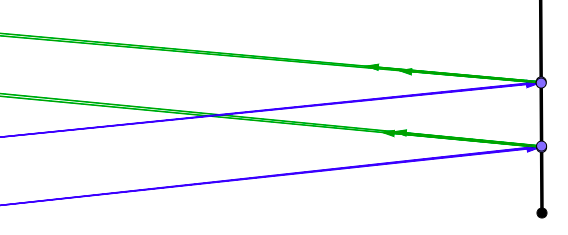
The focal length of a plane mirror is:
(a). Positive
(b). Negative
(c). Zero
(d). Infinity
Answer
595.2k+ views
- Hint: Understand about focus, focal length, and their relation with each other. Also, about the nature of the image formed in the plane mirror when the object is placed at different positions. Ray diagrams can be used for the same.
Complete step-by-step solution -
When rays of the light strike on the surface of the mirror they get reflected back. When the rays coming from infinity fall perpendicularly on the surface of the mirror they get reflected back and meet at a point. This point is called the focus. And the distance between pole and focus is called the focal length. The focal length is positive if it is on the left side of the mirror, it is positive if it is on the right side of the mirror, it is zero if reflected rays meet at the pole and it is Infinity if reflected rays never meet.
A plane mirror is a flat reflecting surface. Thus, in the case of a plane mirror, when the parallel rays of light strike the mirror they get reflected back parallel to each other. So, they never meet or we can say they meet at infinity. So, the focal length of the plane mirror is Infinity.

Additional Information:
The image formed by a plane mirror has the following properties:
1) It is virtual and erect.
2) It is of the same size as that of the object.
3) The image distance is equal to object distance.
4) The image formed is laterally inverted.
Uses of the plane mirror:
1) Plane mirrors are used in dressing tables.
2) They are used in periscopes and kaleidoscopes.
3) They are used in microscopes.
4) They are used in solar cookers.
5) They are used in looking glasses.
Note: Focal length is positive if the focus lies on the right side of the mirror. The focal length is negative if the focus lies on the left side of the mirror. And, the focal length is zero if the focus lies on the mirror. Draw ray diagrams of light rays coming from infinity and when an object is placed at different positions. This will help in understanding the concept in a better way.
Complete step-by-step solution -
When rays of the light strike on the surface of the mirror they get reflected back. When the rays coming from infinity fall perpendicularly on the surface of the mirror they get reflected back and meet at a point. This point is called the focus. And the distance between pole and focus is called the focal length. The focal length is positive if it is on the left side of the mirror, it is positive if it is on the right side of the mirror, it is zero if reflected rays meet at the pole and it is Infinity if reflected rays never meet.
A plane mirror is a flat reflecting surface. Thus, in the case of a plane mirror, when the parallel rays of light strike the mirror they get reflected back parallel to each other. So, they never meet or we can say they meet at infinity. So, the focal length of the plane mirror is Infinity.

Additional Information:
The image formed by a plane mirror has the following properties:
1) It is virtual and erect.
2) It is of the same size as that of the object.
3) The image distance is equal to object distance.
4) The image formed is laterally inverted.
Uses of the plane mirror:
1) Plane mirrors are used in dressing tables.
2) They are used in periscopes and kaleidoscopes.
3) They are used in microscopes.
4) They are used in solar cookers.
5) They are used in looking glasses.
Note: Focal length is positive if the focus lies on the right side of the mirror. The focal length is negative if the focus lies on the left side of the mirror. And, the focal length is zero if the focus lies on the mirror. Draw ray diagrams of light rays coming from infinity and when an object is placed at different positions. This will help in understanding the concept in a better way.
Recently Updated Pages
Master Class 12 Business Studies: Engaging Questions & Answers for Success

Master Class 12 Economics: Engaging Questions & Answers for Success

Master Class 12 English: Engaging Questions & Answers for Success

Master Class 12 Maths: Engaging Questions & Answers for Success

Master Class 12 Social Science: Engaging Questions & Answers for Success

Master Class 12 Chemistry: Engaging Questions & Answers for Success

Trending doubts
What are the major means of transport Explain each class 12 social science CBSE

Which are the Top 10 Largest Countries of the World?

Draw a labelled sketch of the human eye class 12 physics CBSE

Explain sex determination in humans with line diag class 12 biology CBSE

The pH of the pancreatic juice is A 64 B 86 C 120 D class 12 biology CBSE

Give 10 examples of unisexual and bisexual flowers




